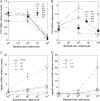Regulation of hepatic cytochrome P450 expression in mice with intestinal or systemic infections of citrobacter rodentium
- PMID: 18971315
- PMCID: PMC2631938
- DOI: 10.1124/dmd.108.024240
Regulation of hepatic cytochrome P450 expression in mice with intestinal or systemic infections of citrobacter rodentium
Abstract
We reported previously that infection of C3H/HeOuJ (HeOu) mice with the murine intestinal pathogen Citrobacter rodentium caused a selective modulation of hepatic cytochrome P450 (P450) gene expression in the liver that was independent of the Toll-like receptor 4. However, HeOu mice are much more sensitive to the pathogenic effects of C. rodentium infection, and the P450 down-regulation was associated with significant morbidity in the animals. Here, we report that oral infection of C57BL/6 mice with C. rodentium, which produced only mild clinical signs and symptoms, produced very similar effects on hepatic P450 expression in this strain. As in HeOu mice, CYP4A mRNAs and proteins were among the most sensitive to down-regulation, whereas CYP4F18 was induced. CYP2D9 mRNA was also induced 8- to 9-fold in the C57BL/6 mice. The time course of P450 regulation followed that of colonic inflammation and bacterial colonization, peaking at 7 to 10 days after infection and returning to normal at 15 to 24 days as the infection resolved. These changes also correlated with the time course of significant elevations in the serum of the proinflammatory cytokines interleukin (IL)-6 and tumor necrosis factor-alpha, as well as of interferon-gamma and IL-2, with serum levels of IL-6 being markedly higher than those of the other cytokines. Intraperitoneal administration of C. rodentium produced a rapid down-regulation of P450 enzymes that was quantitatively and qualitatively different from that of oral infection, although CYP2D9 was induced in both models, suggesting that the effects of oral infection on the liver are not due to bacterial translocation.
Figures








References
-
- Aitken AE, Richardson TA, and Morgan ET (2006) Regulation of drug-metabolizing enzymes and transporters in inflammation. Annu Rev Pharmacol Toxicol 46 123–149. - PubMed
-
- Beutler B, Du X, and Poltorak A (2001) Identification of Toll-like receptor 4 (Tlr4) as the sole conduit for LPS signal transduction: genetic and evolutionary studies. J Endotoxin Res 7 277–280. - PubMed
-
- Blume N, Leonard J, Xu ZJ, Watanabe O, Remotti H, and Fishman J (2000) Characterization of Cyp2d22, a novel cytochrome P450 expressed in mouse mammary cells. Arch Biochem Biophys 381 191–204. - PubMed
-
- Caradonna L, Amati L, Magrone T, Pellegrino NM, Jirillo E, and Caccavo D (2000) Enteric bacteria, lipopolysaccharides and related cytokines in inflammatory bowel disease: biological and clinical significance. J Endotoxin Res 6 205–214. - PubMed
Publication types
MeSH terms
Substances
Grants and funding
LinkOut - more resources
Full Text Sources
Medical
Research Materials

